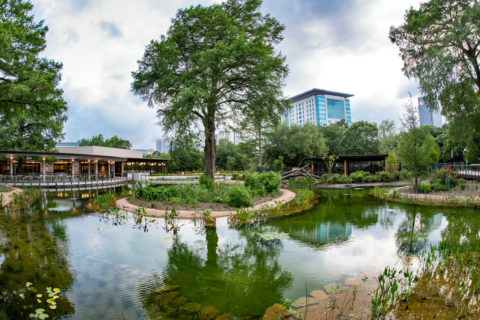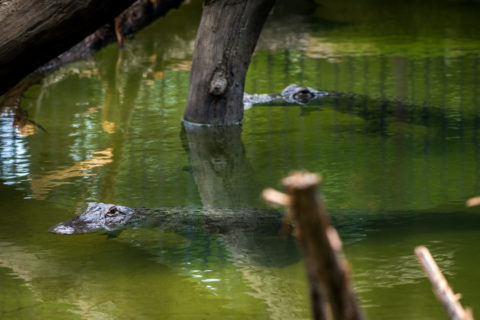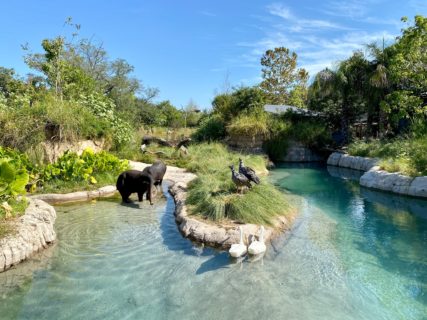Celebrating World Wetlands Day
 Looking out over the Kathrine G. McGovern Texas Wetlands exhibit at Houston Zoo, you can’t help noticing the complex system of wildlife fluttering overhead and bubbling at your feet. Minnows darting just beneath the water’s surface, the plop of a bullfrog among the reeds, the hum of insects, the sparrows flitting between the branches of the cypress trees.
Looking out over the Kathrine G. McGovern Texas Wetlands exhibit at Houston Zoo, you can’t help noticing the complex system of wildlife fluttering overhead and bubbling at your feet. Minnows darting just beneath the water’s surface, the plop of a bullfrog among the reeds, the hum of insects, the sparrows flitting between the branches of the cypress trees.
Wetlands are the most diverse habitats on Earth. They can be seasonal or permanent, freshwater or saltwater, tropical or temperate. They support hydrophytic (“water loving”) vegetation and a staggering amount of species. Invertebrates, fish, reptiles, mammals, and birds — Zoo staff have recorded more than 150 animal species in our Texas Wetlands. Although the exhibit focuses on three North American wetland species that were brought back from the brink of extinction – the bald eagle, American alligator, and whooping crane — Texas Wetlands is filled with volunteer species that have come to call our wetlands home. Like other wetlands, it’s also a seasonal waystation for migrating birds. From winter’s yellow-rumped warblers and ruby-crowned kinglets to spring’s Carolina wrens and common yellowthroats, wildlife in our wetlands changes throughout the year.

Nearby on Zoo grounds is another reminder of the variety of wetlands across the world and the wildlife they support. South America’s Pantanal exhibit immerses guests in the tropical wetlands of Brazil. The Brazilian Pantanal is the largest tropical wetland and flooded grassland area in the world, where the diverse wildlife includes jaguars, giant anteaters, tapirs, otters, and capybaras living alongside macaws, anacondas, and poison dart frogs.
 Beyond their staggering amount of biodiversity, wetlands provide other ecosystem services that humans rely on. They prevent flooding by absorbing excess rainwater and can provide a natural buffer to dampen storm surges. Wetland plants help prevent erosion by stabilizing the soil and slowing down the velocity of water runoff during heavy rainfalls. They also absorb and filter out pollutants, naturally cleaning water. This is how wetlands have come to be called Earth’s kidneys. Wetlands also sequester carbon, storing it in their plants and soils. Wetlands are estimated to store two times the carbon in their soils as all tropical forests.
Beyond their staggering amount of biodiversity, wetlands provide other ecosystem services that humans rely on. They prevent flooding by absorbing excess rainwater and can provide a natural buffer to dampen storm surges. Wetland plants help prevent erosion by stabilizing the soil and slowing down the velocity of water runoff during heavy rainfalls. They also absorb and filter out pollutants, naturally cleaning water. This is how wetlands have come to be called Earth’s kidneys. Wetlands also sequester carbon, storing it in their plants and soils. Wetlands are estimated to store two times the carbon in their soils as all tropical forests.
Unfortunately, 90% of the world’s wetlands have suffered degradation or have been lost altogether in the last few hundred years, and humans are largely responsible. Wetlands remain a vulnerable ecosystem, as we continue to lose wetlands at three times the rate that we’re losing forests. That’s in part why World Wetlands Day has been celebrated since 1997 as a way to acknowledge the importance of this critical ecosystem. This year, World Wetlands Day is focusing on the connection between wetlands and human wellbeing.
What can you do to celebrate World Wetlands Day? Go visit a local wetland. Volunteer with a wetland restoration group. Create a wetland habitat in your community or even your backyard. And, of course, visit Houston Zoo, where your visit helps save wetland wildlife.
